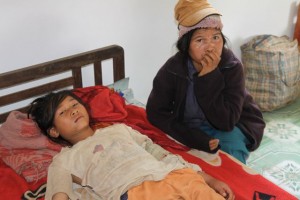Project Sekong 2012: After a tree fell on the girl, it took more than a day for her family to reach help.

After the accident this girl's family spent a full day trying to arrange transport to the closest clinic. The next morning, in frustration, they gave up and started out on foot, carrying her in a hammock. She finally arrived at our village clinic on the floor of a wagon pulled by a small tractor.
Report 6
En route to a new worksite we always visit hospitals and clinics along the way to determine what resources are available should someone on our team need emergency medical attention.
The hierarchy runs from provincial hospital, to district hospital to village clinic (sometimes labeled “dispensary”). The provincial and district hospitals typically have staff trained to a level that the Lao classify as “doctor” although that training will be below American standards. Far below.
A village clinic is commonly staffed by a nurse who graduated from secondary school and attended a yearlong medical training program that emphasized “first responder” skills and community health. I don’t know the quality of a nurse’s classroom education but, once posted to a remote location, he or she will endure a baptism by fire and quickly reap a wealth of practical experience.
Village nurses usually have responsibility for several villages, some more than a day’s walk from home. Periodically, a nurse must leave the relative security of the clinic and set out on foot or motorbike to make a weeklong circuitous journey to check on the health of all villages under his or her care.
Unfortunately, village nurses have few resources to share with the sick or injured. What meager provisions they receive from the district hospital must be reserved for critical cases, and rarely does a clinic storeroom hold supplies equal to just one of our team’s medical kit. In the past we’ve seen injured villagers turned away because the clinic was out of sutures, splints or bandages. And, clinic hygiene is often compromised by a shortage of gloves, disinfectant, or even common household soap.
The village nurse here just received word from a runner that a tree fell onto a small girl and broke her arm. Her family has put her in a hammock and is carrying her from their village to our clinic. (I know from earlier conversation with the nurse that he has no store-bought splints. Yesterday, he told me that when he has to stabilize fractured limbs he must “make splint from nature”).
Update:
Somewhere between their village and Dak Door the injured girl’s family encountered a farmer pulling a small wagon with a two-wheeled “Chinese tractor”. The farmer took pity and offered a ride. The family piled into the wagon and continued on.
When they arrived here at our camp and clinic, the parents lifted the girl and struggled to climb out of the wagon. When Yai heard the girl cry out in pain he jumped in and proffered our medic’s stretcher. Together Yai and our driver carried the litter into the clinic.
Just about every case of illness or injury her in Laos is judged to merit an IV. So… before even looking at the girl’s arm, the nurse slipped on a pair of plastic gloves, cleaned the girl’s arm, located a healthy vein, and started a drip.
We’ve learned that the initial report was mistaken. The girl was not injured today. She broke her arm yesterday morning. Her parents applied a splint and then spent the rest of the day trying to organize transportation. When their best efforts failed they resolved to spend the night at home and set out on foot this morning. So… for the past twenty-four hours the girl has been in pain with little prospect of help.
In cases like these, the village nurse, after stabilizing the patient, will arrange for a car to be sent from the district hospital to carry the patient either back there or on to the provincial hospital. Sadly, in this case, our nurse couldn’t call for transfer immediately because his cell phone was dead.
When Yai learned of the delay, he offered his phone but couldn’t get enough bars to place the call. He then offered my phone, which uses a different system. Eventually, the doctor succeeded in requesting transport and is hopeful that a vehicle will arrive later this morning.
Interestingly, the girl’s parents have requested that she be transported, not to the district hospital but to a temple in a neighboring province that offers herbal treatments that the family prefers to “Western” medicine.
I’m certain that there is much more of this story to unfold.
